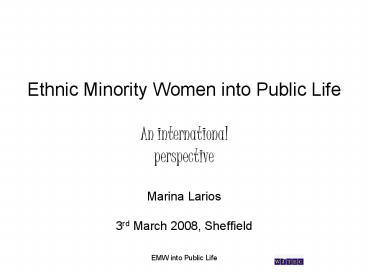Ethnic Minority Women into Public Life
1 / 18
Title:
Ethnic Minority Women into Public Life
Description:
'If women are to have any say in the lives they lead, they must enter politics. ... Institute for Democracy and Electoral Assistance (International IDEA) is an ... –
Number of Views:40
Avg rating:3.0/5.0
Title: Ethnic Minority Women into Public Life
1
- Ethnic Minority Women into Public Life
- An international
- perspective
- Marina Larios
- 3rd March 2008, Sheffield
2
Equality and Empowerment
- "If women are to have any say in the lives they
lead, they must enter politics. - Fernanda Nissen
(1862-1920), - Norwegian feminist and politician
Source http//www.adressa.no/nyheter/trondheim/by
ens_gater/article622687.ece?servicebigImagemySta
rt1
3
(No Transcript)
4
Challenges
- the prevalence of the masculine model of
political life and of elected governmental bodies - lack of accessible, clear information about
the processes - lack of role models
- lack of experience
- lack of training or access to training to develop
new skills - lack of adequate support services, for example
childcare. - Source http//www.thewnc.org.uk/pubs/womenpublicl
ife.pdf, page 10.
5
Ideological and psychological challenges
- Women's lack of confidence to run for elections
- Women's perception of politics as a dirty game
and - The way in which women are portrayed in the mass
media. - More challenges for BME women
- Source http//www.idea.int/publications/wip/uploa
d/1_Shvedova.pdf, page 8.
6
- 1,000
- Source http//www.dwp.gov.uk/mediacentre/pres
sreleases/2007/oct/drc052-291007.asp
7
- Same global challengesbut some countries are
addressing them in different ways..how?
8
Women in public life numbers
Source http//w3.unece.org/pxweb/DATABASE/STAT/30
-GE/05-PublicAnddecision/05-PublicAnddecision.asp
9
Women in national parliaments
Source http//www.idea.int/publications/wip/uploa
d/1_Shvedova.pdf, page 2.
More statistics http//www.womenandequalityunit.g
ov.uk/public_life/parliament.htm
10
Wise council in Pakistan
- Housewife- SHIGAR
- Most Active member in SHIGAR
Source http//www.dfid.gov.uk/pubs/files/gender-e
quality.pdf
11
Case Study Sweden
- Sweden parliament has the highest proportion of
female members in the world - The Swedish Parliament (Riksdag) has the highest
proportion of female members in the world (43). - In Sweden, the policy of equal distribution of
power and decision-making aims to achieve a 50
per cent balance between women and men as members
of the state boards and committees at both the
central and regional level. - Reports on this topic are sent to Parliament
annually - Organisations are requested to submit proposals
naming two individuals (a woman and a man) so
that the government can choose who will be
represented on a committee or a state board - Financial support is given to stimulate women's
representation in local governments. - Source http//unece.org/gender/genpols/keyinds/pu
blife/sweden.htm
12
Case study International IDEA
- The International Institute for Democracy and
Electoral Assistance (International IDEA) is an
intergovernmental organization that supports
sustainable democracy worldwide. - Key findings (Women in Parliament. Beyond
numbers) include - It is not all about numbers - While a critical
mass of women is necessary to ensure womens
representation, the quality of the representation
is just as important. Training is crucial to
avoid the trap of electing token women. - Gender perspectives, not gender issues - Women
elected to parliament change politics globally
they introduce a womens perspective into all
areas of political life, they are not limited to
gender issues. - Source http//www.idea.int/gender/wip_handbook.cf
m
13
Case study Ukraine
- PROJECT OLGA (a joint project between the UNDP
and a Swedish development consultancy) - Activities
- 1. training of regional politicians (seminars and
follow-up activities) - 2. launching the men's project with the specific
focus on - men's perspectives on changing
gender roles and - violence against women
and children. - 1,200 people took part (60 of which were women)
- The project's achievements
- - issues of gender equality and women's political
leadership have received wider recognition and
public support all over the Ukraine - a constructive dialogue between women and men has
been established that will lead to greater gender
equality. - Source http//unece.org/gender/genpols/keyinds/p
ublife/ukraine.htm
14
Case Study Norway
- Policy aims to have women constituting 40 per
cent of the composition of MPs and government
employees - use of the party system the voters actually vote
for parties, not individuals. This kind of
selection process provides a good basis for women
seeking political power - Quotas have proved an effective means of
achieving a more equal distribution of women and
men in political institutions. - Surveys show that there are clear, gender-based
divisions with regard to the political spheres
dealt with by men and women politicians. - Source http//www.regjeringen.no/nb/dep/bld/Rydde
mappe/SLA-Avdeling/doc/legislation/guidelines/Wome
n-in-Politics.html?id437166
15
Increasing participation in public life
Recommendations
- Greater use of quotas and targets to increase the
representation of BME women . - Mentoring schemes training schemes
- Knowledge sharing- increasing networking
opportunities - Addressing the Iceberg as a whole?
- Source LISTENING TO BLACK AND ETHNIC MINORITY
WOMENS VOICES SEMINAR REPORT JUNE 2005 - http//www.fawcettsociety.org.uk/documents/LISTENI
NG20TO20BLACK20AND20ETHNIC20MINORITY20WOMEN.
doc, page 5f.
16
Conclusion
- Womens participation in public life is not only
womens business it is everybodys business.
Increasing the number and strength of womens
voices leads to better and more representative
decision-making.
Source http//www.dfid.gov.uk/pubs/files/gender-e
quality.pdf pag.21
17
Resources
- Case studies of women in public life in the UK
- Please see http//www.thewnc.org.uk/pubs/womenpubl
iclife.pdf, page 28 42.
18
Thank you!
- Marina Larios
- mlarios_at_inovaconsult.com































